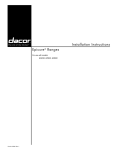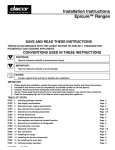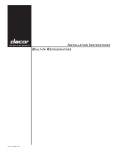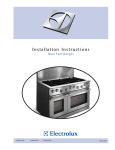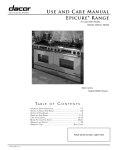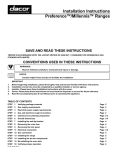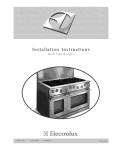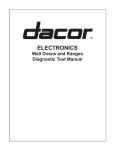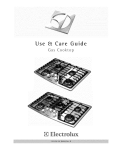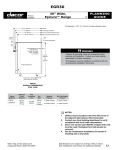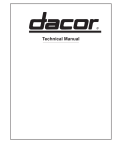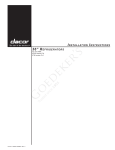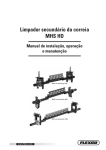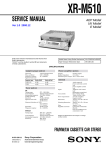Download Dacor ERD36 Specifications
Transcript
I n stall at i o n I n str u ct i o n s E p i c u r e™ R an g es For use with models: ERD30, version ERD36, version ERD48, version ERD60, version EGR30, version ERDE36, version ERDE 48, version Part No. 65089 Rev. H Table of Appliance Safety...........................................................................1 Important Safety Instructions......................................................2 Design Specifications...................................................................3 Product Dimensions........................................................................3 Installation Specifications............................................................4 Verifying Package Contents........................................................4 Gas Supply Requirements...........................................................4 Electrical Power Supply Requirements.......................................4 Gas & Electrical Rough-In Locations........................................4-5 Cabinet & Countertop Preparation...........................................5-6 Gas Regulator & Electrical Conduit Location.............................. 7 Contents Installing the 36" & 48" Backguard..............................................7 Electrical Requirements...............................................................8 Electrical Connections.................................................................8 Electrical Connections - ERD Model Ranges Only..................8-9 Gas Connection...........................................................................9 Installing the Range.....................................................................9 Installing the Burner Components...............................................9 Re-Installing the Oven Doors......................................................9 Installation Instructions..............................................................10 Verifying Proper Operation........................................................10 Appliance Safety What You Need to Know About Safety Instructions Warning and Important Safety Instructions appearing in this guide are not meant to cover all possible conditions and situations that may occur. Common sense, caution and care must be exercised when installing, maintaining or operating appliance. Always contact Dacor® about problems or conditions you do not understand. Safety Symbols, Words, Labels DANGER DANGER – Immediate hazards which WILL result in severe personal injury or death. WARNING WARNING – Hazards or unsafe practices which COULD result in severe personal injury or death. CAUTION CAUTION – Hazards or unsafe practices which COULD result in minor personal injury or property damage. Installation Recommendations The importance of the installation of your new appliance cannot be overemphasized. Installation should be done by a qualified installer. Before you begin the installation process, it is recommended that you read this entire Installation Instruction Manual. There are key details that you should take special care to observe during the installation. By reading these instructions carefully, you will make the installation process easier, problem-free and, most importantly, safe. Any questions or problems with the installation should be directed to your Dacor® dealer or the Dacor® Customer Service Department at 800.793.0093 or email customerservice@ dacorworld.com. You can also visit our website at www.Dacor. com. Important Safety Instructions WARNING 1. Read all instructions before using the appliance. 7. This appliance must not be used in combination with surface (countertop) ventilation systems. The use of an overhead hood is recommended for ventilation. 8. This appliance must be installed with the gas pressure regulator supplied with it. 9. Disconnect the electrical supply before installing or servicing the appliance. 2. If the information in this manual is not followed exactly, a fire or explosion may result causing property damage, personal injury, or death. 3. 4. • • • • • 5. • • • • 6. Improper installation, adjustment, alteration, service, or maintenance can cause personal injury or property damage. Refer to these instructions and the accompanying Use & Care Manual. For assistance or additional information, consult a qualified installer, service agency, manufacturer (dealer), or the gas supplier. What to do if you smell gas: Do not try to light any appliance. Do not touch any electrical switch, do not use any phone in your building. Immediately call the gas supplier from a neighbor’s phone. Follow the gas supplier’s instructions. If you cannot reach your gas supplier, call the fire department. For your safety: Do not store or use gasoline or other flammable vapors and liquids in the vicinity of this or any other appliance. Do not obstruct the flow of combustion and ventilation air to the unit. Keep appliance area clear and free from combustible material. Do not use or attempt to use this appliance in the event of a power failure. This unit is designed as a cooking appliance. Never use it for warming or heating a room. 10. This appliance must be grounded. Connect only to a properly grounded electrical supply. Refer to “Electrical Requirements”. 11. Install or locate this appliance only in accordance with these installation instructions. 12. Use this appliance only for its intended use as described in this manual. Do not use corrosive chemicals or vapors in this appliance. This type of appliance is not designed for industrial or laboratory use. 13. As with any appliance, close supervision is necessary when used by children. 14. Do not operate this appliance if it has a damaged electrical cord, plug, conduit or wires, if it is not working properly, or if it has been damaged or dropped. 15. Installation of this appliance must be performed by a qualified installer, service agency or the gas supplier. 16. This appliance should be serviced only by qualified service personnel. Contact the nearest DACOR® Authorized Servicer at (800) 772-7778, or at www.dacor.com for examination, repair or adjustment. NOTES: 1. Some products, such as whole eggs, and sealed containers, such as closed glass jars, may explode and should not be heated on this cooktop. WARNING WARNING – NEVER cover any slots, holes or passages in the oven bottom or cover an entire rack with materials such as aluminum foil. Doing so blocks air flow through the oven and may cause carbon monoxide poisoning. Aluminum foil linings may also trap heat, causing a fire hazard. Design Specifications Product Dimensions NOTE: For ERD all front-to-back depth dimensions are reduced by 1” (25mm) when Backguard and full side panels are removed. NOTE: For Backguard Installation (36” and 48” models) see 30 3/8" (772mm) 29 1/8" (740mm) 28 1/8" (714mm) 26 1/2" (673mm) page 6. Always install backguard before installation of the range. Installing the Anti-Tip Bracket (30” & 36” Models Only) WARNING The 30” and 36” ranges require an anti-tip device. Before installing the range, you must locate and secure the anti-tip bracket to the floor. Handle Front Edge of Bullnose Face of Control Panel/Oven Door Rear of Control Panel/Oven Door 2 3/16” 8 3/8” (56mm) (213mm) Rear Wall 3 7/8" (98mm) 9" (229mm) 19" (483mm) 15 1/4" (387mm) 1 9/16" (40mm) 1 1/2" (38mm) 3" (79mm) 24"(610mm) Backguard 24" (610mm) Floor All Dimensions are from Cabinet Only (Not Countertop) 9" (229mm) Backguard 3" (76mm) Backguard 30 1/16" (764mm) Installation of ERD30 Anti-Tip Bracket Top View 7 1/2" (191mm) Back wall 4 13/16" (122mm) Finished Side Panel 35 1/2” - 38 5/8” (902mm - 981mm) 24" (610mm) 18 1/32" (458mm) 36 1/16" (916mm) ERD36, ERDE36, ERD48 & ERDE48 Overall Dimensions Side View 28 1/2" (724mm) 27" (686mm) All Dimensions are from Cabinet Only (Not Countertop) Installation of ERD36 Anti-Tip Bracket Top View Handle Front Edge of Bullnose 26" (660mm) Face of Control Panel/Oven Door 24 3/8" (619mm) Rear of Control Panel/Oven Door Rear 6” (152mm) Backguard 1 9/16" (40mm) When Backguard and Side Panels are removed, the overall depth decreases by 1" (25mm) Leveler 5/16 - 18 x 2 or Equivalent Left Rear Leg Location of ERD30 Anti-Tip Leveler 37” (940mm) to 35 3/4" (908mm) Finished Side Panel Rear Accessory 3” (76mm) Side Panels (Dacor Model No. AESP03) ERD/EGR30, ERD60 Overall Dimensions Side View Leveler 5/16 - 18 x 2 or Equivalent Left Rear Leg Location of ERD36 Anti-Tip Leveler Installation Specifications Verifying the Package Contents Verify that all required components have been provided. If any item is missing or damaged, please contact your dealer immediately. Do not install a damaged or incomplete appliance. • Use & Care Manual • Ignitor Cleaning Kit • Broiler Pan/Grill • Anti-tip Bracket (selected models) • Grate/Burner Cap Packs • Griddle • Burner Rings • Wok Ring • Simmerplate • Spatula • Stainless Steel Cleaner • Pry Stick Gas Supply Requirements Dacor® Model No. EGR30 EGR30LP Electrical Circuit Required Total Connected Load 120VAC, 60Hz, 15A 0.75kW (6A) ERD30 4.2kW (22A) ERD30LP ERD36 120/240VAC, 60Hz, 30A 4.7kW (24A) ERD36LP ERDE36 ERDE36LP 120/240VAC, 60Hz, 40A ERD48 10.0kW (46A) ERD48LP ERDE48 120/240VAC, 60Hz, 50A 10.8kW\ (48A) ERDE48LP ERD60 ERD60LP 120VAC, 60Hz, 30A Check your local building codes for the proper method of installation. In the absence of local codes, this appliance should be installed in accordance with the National Fuel Gas Code ANSI Z223.1. Be certain that the appliance being installed is correct for the gas service being provided. Refer to the data plate located behind the inlet air cooling grill, and/or the table to the right, for gas supply requirements. Open the oven door and remove the inlet air cooling grill for access to the data plate. WARNING This appliance must be installed by a licensed plumber or gas fitter when installed within the Commonwealth of Massachusetts. Electrical Power Supply Requirements It is the owner’s responsibility to ensure that the electrical connection of this appliance is performed by a qualified electrician. The electrical installation, including minimum supply wire size and grounding, must be in accordance with the National Electric code ANSI/NFPA 70-1993* (or latest revision) and local codes and ordinances. *A copy of this standard may be obtained from: National Fire Protection Association 1 Batterymarch Park Quincy, Massachusetts 02269-9101 The correct voltage, frequency, and amperage must be supplied to the appliance from a separate, grounded, circuit that is protected by a properly sized circuit breaker or time delay fuse. Refer to the data plate, and/or the table to the right, for gas supply requirements. 7.7kW (34A) 4.1kW (21A) Gas Type Manifold Pressure Min. Gas Supply Pressure Natural 5” Water Column 6” Water Column Liquid Propane 10” Water Column 11” Water Column Natural 5” Water Column 6” Water Column Liquid Propane 10” Water Column 11” Water Column Natural 5” Water Column 6” Water Column Liquid Propane 10” Water Column 11” Water Column Natural 5” Water Column 6” Water Column Liquid Propane 10” Water Column 11” Water Column Natural 5” Water Column 6” Water Column Liquid Propane 10” Water Column 11” Water Column Natural 5” Water Column 6” Water Column Liquid Propane 10” Water Column 11” Water Column Natural 5” Water Column 6” Water Column Liquid Propane 10” Water Column 11” Water Column Gas and Electrical Supply Requirements WARNING If the gas or electric service provided does not meet the product specifications, do not proceed with the installation. Call the selling dealer, the gas supplier, or a licensed electrician. NOTES: 1. The power supply must be properly polarized. Reverse polarity will result in continuous sparking of the electrodes, even after flame ignition. 2. If there is any doubt as to whether the power supply is properly polarized or grounded, have it checked by a qualified electrician. 3. Two electrical circuits and gas supplies are required for the ERD60. Gas & Electrical Rough-In Locations NOTE: The shaded areas shown in the illustrations, denote the location of the gas stub and the electrical junction box/receptacle. These are suggested locations. For replacement purposes, the location of the existing utilities may be utilized provided that they do not interfere with the sides or rear of the range. If installing the gas valve behind the range, verify that local building codes will permit this. A manual shut valve must be installed in the gas piping, external to the appliance, for the purpose of turning on or shutting off gas to the appliance. Plan the location of the range and the gas supply to allow access to the valve when the unit is installed. Access to the remote circuit breaker panel/fuse box, with the range in place, must also be allowed for in the installation. Any openings in the wall behind the appliance and in the floor under the appliance must be sealed. Installation Specifications Both the gas supply piping and shut-off valve, and the electrical junction box/receptacle must be located so they do not interfere with the range when it is installed. In addition, the junction box must be located so the range can be removed for service when the conduit supplied with the unit is attached to the junction box. Do not lengthen the conduit or wiring provided with the range. All dimensions shown are based on standard American cabinets 36 inches (914mm) high at the finished countertop by 24 inches (610mm) deep, with a 25 inch (635mm) overall countertop depth. When installing the range into nonstandard cabinets, minimum clearances shown in the diagrams on page 3 must be maintained. Carefully check the location where the range is to be installed. For best performance, the range should be placed away from drafts that may be caused by doors, windows and HVAC outlets. Cabinet & Countertop Preparation NOTES: 1. If cabinet storage space is to be provided directly above the range, the risk of personal injury may be reduced by installing a ventilating hood that projects horizontally a minimum of 5 inches beyond the face of the cabinets. 2. The range may be installed flush to the rear wall. We recommend installing a non-combustible material on the rear wall above the range and up to the vent hood. It is not necessary to install noncombustible materials behind the range below the countertop height. 3. The minimum distance from the sides of the range above the countertop to combustible side walls must be at least 10 inches. NOTE: On 36” and 48” models, install either the 3”, 9” or 24” Backguard on the Range prior to installing the Range into the cabinet cutout. A NOTE: Utilities may be located: In the lower left corner of the adjacent right cabinet. (Recommended) Hood IMPORTANT: Contact your local building department to verify compliance with local code interpretation. 13" (330mm) Maximum Top of finished counter Vertical non-combustible surface 18" (457mm) Minumim 30" (762mm) Minimum B 8" (203mm) 12" (305mm) 10" (254mm) Min. to combustible side walls above the range (both sides) 25" (635mm) Model Number ERD30 EGR30 ERD36 ERDE36 ERD48 ERDE48 ERD60 ERD36 & ERD48 “A” “B” 36” (914mm) Recommended 30” (762mm) Minimum 30 1/16” (764mm) 42” (1067mm) Recommended 36” (914mm) Minimum 36 1/16” (203mm) 54” (1372mm) Recommended 48” (1219mm) Minimum 48 1/8” (1222mm) 66” (1676mm) Recommended 60” (1542mm) Minimum 60 1/8” (1572mm) Cutout Dimensions Installation Specifications 3/4" (19mm) Max. backsplash 1/4" (6mm) Min. flat ledge Rear wall Rear wall Vertical non-combustible surface 20 3/16" (513mm) 23 3/16" (589mm) Variable 13/16" - 3 13/16" (21 - 97mm) 13/16" (21mm) 13/32" (10mm) 29 1/4" (743mm) 30 1/16" (764mm) 29 1/4" (743mm) 30 1/16" (764mm) ERD/EGR30 Slide-In, Self-Rimming Installation with Side Panels and Backguard Removed Top View Vertical non-combustible surface rear wall Vertical non-combustible surface 27 7/8" (708mm) 27 13/16" (706mm) 13/32" (10mm) ERD/EGR30 Slide-In, Self-Rimming Installation using 3” Side Panels (Model No. AESP03), Backguard Removed. Top View Backsplash thicker than 3/4" (19mm) 1/4" (6mm) Min. flat ledge 2 13/16" (71mm) Adjust for backsplash over 3/4" thick from 13/16" to 3 13/16" (21 - 97mm) 13/32" (10mm) 29 1/4" (743mm) 30 1/16" (764mm) Countertop overhangs cabinet 6" (152mm) Min. to combustible side walls above the range (both sides) ERV30 with ERD30 Slide-In, Self-Rimming Installation using 3” Side Panels (Model No. AESP03), Backguard Removed. Top View Vertical non-combustible surface rear wall 27 7/8" (708mm) 3/4" (19mm) Max. backsplash 27 13/16" (706mm) 23 3/16" (589mm) 1/4" (6mm) Min. flat ledge 2 13/16" (71mm) 13/16" (21mm) 13/32" (10mm) 29 1/4" (743mm) 30 1/16" (764mm) Countertop overhangs cabinet 6" (152mm) Min. to combustible side walls above the range (both sides) ERV30 with ERD30 Slide-In, Self-Rimming Installation with Side Panels and Backguard Removed Top View Installation Specifications Gas Regulator and Electrical Conduit Location ERD with 9” Flue Extension (9" flue extension shown) Factory installed 3/4" regulator (1/2" supply ok) Power cord Gas Regulator and Electrical Conduit Location Rear View Installing the 36" Backguard and 48" Range Your DACOR® range was equipped with a shipping cover to protect the internal components prior to installation. This cover must be removed and replaced by a DACOR® backguard for your range to function properly. ERD48 with 9” Flue Extension (9" flue extension shown) 5. 6. WARNING Be sure that the unit is not connected to gas or power before proceeding. 7. 1. 2. 3. Remove the backguard from its box. To avoid scratches, place small scraps of thin cardboard on the rear of the side panels where the backguard will make contact. With the assistance of at least one other person, carefully lift the backguard over the exhaust flues and place down on to the range top. Special attention should be given to the lower flange in front of the backguard, which must fit between the stainless steel side panels. Fasten the provided screws through the rear flange. Unpack the contents of the box and verify parts with the Packing List. Remove the single screw on the top of the shipping cover. Slide the shipping cover off the unit. Backguard Flue with Extension (9" and 24" only) Remove Screw ERD Backguard Installation Shipping Cover Shipping Cover Flue with Extension (9" and 24" only) Backguard ERD48 Backguard Installation Shipping Cover Removal (36” range shown) 4. Locate and install the flue exhaust extensions at the rear of the range (9" and 24" backguards only). Use the provided hex screws and tighten securely into the pre-drilled holes. NOTE: For 24” Backguards, fasten the provided screws through the holes in the back panel of the Backguard. 8. 9. Connect the gas line to the regulator. Reposition and attach the access panel or the back cover if the entire back cover was removed. You are now ready to continue with the range installation. Installation Instructions Electrical Requirements Hinge Catch WARNINGS: 1. 2. Do not attempt to disengage the hinge catches with the door removed from the oven. The hinge springs could release causing personal injury. Do not lift or carry the oven door by the door handle. Hinge Catch To remove door , rotate catch up. 30° Lift door up to 30° angle, then pull door away from the range oven section Open the door to its fully opened position. Rotate the catch over the retaining arm on each hinge. Lift the oven door to about a 30 degree angle from the horizontal position. Pull the door away from the oven while continuing to lift. Electrical Connections To remove door , rotate catch up. Removing the Oven Door 30° WARNINGS: WARNING 1. ERD models must be connected to a grounded, metallic, permanent wiring system. Alternatively, a grounding conductor should be connected to the grounding terminal or lead on the appliance. 2. ERG models must be connected to a grounded receptacle. Failure to do so may result in an electrical shock hazard. 3. Do not use an extension cord with this appliance. Such use may result in fire, electrical shock, or other personal injury. 4. Do not install a fuse in the neutral or ground circuit. A fuse in the neutral or ground circuit may result in an electrical shock hazard. Grounding Instructions (ERD Models Only) This appliance must be electrically grounded. With the range positioned directly in front of the cabinet cutout, feed the appliance conduit to the electrical junction box. Then, depending upon local codes, utilize one of the following techniques to connect the appliance to the electrical power supply: A. Connecting to a Four-Wire Electrical System 1. Separate the green and white appliance wires. 2. Connect the white Cable from power supply appliance wire to the neutral (white) supply wire in the junction box. 3. Connect the black appliance wire to the black (L1) RED WHITE power supply wire RED WHITE in the junction box. 4. Connect the red GREEN BLACK GREEN appliance wire to BLACK the red (L2) power supply wire in the junction box. 5. Connect the green appliance wire to the green house grounding wire in the junction box. Conduit from appliance Connecting the appliance to a four-wire power supply Lift door up to 30° angle, then pull door away from the range oven section. Junction box Wire nut (4 places) **Do not connect the green appliance wire to the neutral (white) supply wire unless local building codes permit. Cable from power supply Junction box RED RED GREEN WHITE WHITE BLACK BLACK Wire nut (3 places) Conduit from appliance **Connecting the appliance to a three-wire power supply Electrical Connections - ERD Model Ranges Only B. Connecting the Green Appliance Wire to the Neutral (White) Supply Wire – Where Local Codes Permit 1. Connect the green and white appliance wires to the neutral (white) supply wire in the junction box. 2. Connect the black appliance wire to the black (L1) power supply wire in the junction box. 3. Connect the red appliance wire to the red (L2) power supply wire in the junction box. C. Connecting the Green Appliance Wire to a Grounded Supply Wire or a Grounded Cold Water Pipe – Where Local Codes Permit. 1. Separate the green and white appliance wires. 2. Connect the white appliance wire to the neutral (white) supply wire in the junction box. 3. Connect the black appliance wire to the black (L1) power supply wire in the junction box. 4. Connect the red appliance wire to the red (L2) power supply wire in the junction box. Installation Instructions 5. 6. Connect the green appliance wire to a grounded supply wire in the junction box or to a grounded cold water pipe. If connecting to a grounded cold water pipe, a separate copper grounding wire (No. 10 minimum) must be connected to a grounded cold water pipe by means of a clamp and then to an external grounding connector screw. WARNINGS: 1. Do not ground the appliance to a gas supply pipe or hot water pipe. 2. Do not turn on power to the appliance until the range is permanently grounded. Cable from power supply Separate No. 10 (minimum) copper grounding wire Junction box RED RED GREEN GREEN No. 4 copper wire WHITE WHITE Clamp must be tight on pipe BLACK BLACK Wire nut (4 places) Metal water pipe Conduit from appliance Connecting the appliance ground to a grounded junction box wire or grounded cold water pipe 3. A grounded cold water pipe must have metal continuity to electrical ground and must not be interrupted by insulating materials. Any insulating materials must be jumped with a length of No. 4 copper wire securely clamped to bare metal at both ends. Gas Connection Before sliding the range into the cabinet, connect a flexible gas connector to the gas shut-off valve previously installed on the stub out. The gas valve must be turned off during installation. Connect the flex connector to the pipe fitting at the right rear of the range. WARNINGS: 1. 2. 3. 4. 5. Do not apply excessive pressure when tightening gas connections and fittings. Do not use teflon tape or plumber’s putty on gas flex line connections. Turn all cooktop control valves to the “OFF” position. Turn on gas supply and check all lines and connections for leaks using a soap and water solution. Do not use a flame to check for leaks. After verifying that there are no gas leaks, turn off the gas supply to the range by turning the gas shut-off valve to the “OFF” position. For LP installations, the LP gas tank must have its own high pressure regulator. This is in addition to the pressure regulator provided with the range. The maximum gas supply pressure to the regulator must never exceed 1/2 pound per square inch. NOTE: The gas pressure regulator is pre-set at the factory for the type of gas intended for use with the appliance. Verify that the appliance is compatible with the type of gas available by checking the data plate located behind the inlet air cooling grill. Open the oven door and remove the inlet air cooling grill for access to the data plate. Ranges intended for use with LP gases will have “LP” as a part of the model number. Consult your dealer if the range is not compatible with your gas supply. Installing the Range Measure from the floor to the countertop and adjust the leveling legs as required to position the top frame at the desired height, based on the cabinet and countertop installation. Carefully slide the range into position in the cutout. The rear anti-tip leg should engage the anti-tip bracket.(30 and 36 inch models only) Meter When the range is to be installed as a “slide-in, self rimming” (with the range top overhanging the countertop cutout - ERD/ERG30 models only), Bare metal measure from the floor to the countertop. Adjust the leveling legs to position the bottom edge of the range top frame approximately 1/8” above the level of the countertop. This will allow the range to slide over the countertop. Carefully slide the range into position in the cutout. The rear anti-tip leg should engage the anti-tip bracket. To lower the range onto the countertop, turn the leveling legs counterclockwise. Lower the range until the bottom of the range top just contacts the countertop. Do not allow the full weight of the range to hang on the counter. Clamps Installing the Burner Components Remove the brass burner rings, porcelain burner caps, and porcelain gates from their shipping packages. Place each burner ring onto its corresponding burner base, being certain that the five alignment tabs slide into the matching notches in the base. Set each porcelain burner cap on top of its corresponding burner ring. Place oven exhaust cover over the opening in the top frame. Place each grate onto the top frame, being certain that the rubber feet are positioned in the locating dimples. WARNINGS: Never attempt to operate the cooktop section of the range with any of the burner rings, burner caps or grates removed. NOTE: Prior to operating the cooktop or oven sections of the range, please read the accompanying Use and Care Manual carefully. Important safety, service and warranty information is contained within this manual Re-Installing the Oven Doors Grasp the oven door on opposite sides and lift it until the door hinges are aligned with the openings in the oven frame. Holding the door at about a 30˚ angle from the horizontal, slide the hinges into the openings until the bottom hinge arms drop fully into the hinge receptacles. Lower the door to the fully opened position, and then rotate the two hinge catches toward the oven. Open and close the door completely to ensure that it is properly installed. Peel off the protective layer of plastic that covers the door panel. Installation Instructions Verifying Proper Operation Before beginning the test procedure, ensure that all cooktop control valves are in the “OFF” position, and all burner rings, burner caps, and grates are properly positioned on the top frame. Turn on the gas supply at the shut-off valve. Turn on the power supply to the range. Set the time of day by pressing the “CLOCK” key and then pressing either of the “TIME•TEMP” keys to advance or reduce the time in the display in the desired setting. Press the “BAKE” key. Select a temperature of 350˚F by pressing the “TIME•TEMP” “+” key. The display should show “BAKE ON”. Press the “CANCEL•SECURE” key to stop the oven heating process. Test each top burner separately by pressing and turning one control knob at a time counterclockwise to the “HIGH” position. All ignitors will spark continuously, but only the burner with gas flowing to it will ignite. (It will take approximately 4 seconds for ignition to occur, at which time the ignitors will stop sparking. If ignition does not occur within 4 seconds, turn off the knob, wait for at least 2 minutes to allow any gas to dissipate, then repeat this ignition test.) The control knob can then be rotated counterclockwise from “HIGH” to “LOW” to adjust the flame height progressively. Repeat the ignition test for all burners. When installed properly, the flame will be steady and quiet. It will also have a sharp, blue inner cone that will vary in length proportional to the burner size. WARNING 1. 2. The range and shut-off valve must be disconnected from the gas supply piping during any pressure testing exceeding 1/2 psi (3.5kPa). The range must be isolated from the gas supply piping by closing the shut-off valve during any pressure testing at or below 1/2 psi (3.5 kPa). NOTES: If either the oven or cooktop does not operate properly, follow these troubleshooting steps: 1. Verify that power and gas are supplied to the range. 2. Check the electrical connections and gas supply to ensure that the installation has been completed correctly. 3. Repeat the above bake test or burner ignition test. 4. If the appliance still does not work, contact an authorized DACOR® service company at (800) 772-7778. Do not attempt to repair the appliance yourself. DACOR® is not responsible for service required to correct a faulty installation. 10 11 Specifications contained within are subject to change without notice. No liability is assumed by DACOR® for changes in specifications. The information and images in this book are the copyright property of Distinctive Appliances, Inc. Neither this book nor any information or images contained herein may be copied or used in whole or in part without the express written permission of Distinctive Appliances, Inc. Web Site: Phone: www.Dacor.com (800) 793-0093 ©2006 Distinctive Appliances, Inc. all rights reserved.














